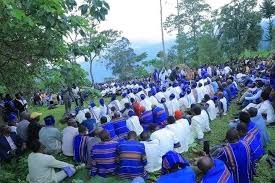BY MULUGETA GUDETA
In April 1966, artists from across Africa and also blacks performers from the Diaspora had gathered in the Senegalese capital Dakar and took part in what is known in history as The First World Festival of Negro Arts. Since then African arts have made big strides in terms of recognition and impact in the global world of cultures although no other African capital city has come forward to organize a festival of arts comparable to the one that took place more than half a century ago. That was the biggest artistic and cultural event that took place in the era of decolonization.
Africa obviously needs a comparable event to take place in any African capital in this time of globalization when the cultural values and legacies of the great African artists are being challenged by the more aggressive cultural forces of a post-colonial world. This is a time for Africa to rise once again and show the world that it has gone a long way in defending its identity and vision for a world where the cultural legacies of Africans should be respected and celebrated.
Dakar was chosen to organize the first black cultural festival for its vibrant contributions to the growth of African arts through its president, the late Leopold Sedar Senghor who was also one of the best black poets and philosophers in a world dominated by Europeans. Commenting on the purpose of the first African artistic festival, Senghor was quoted as saying that, the Dakar festival was an elaboration of the new humanism which this time will include all of humanity on the whole of our planet earth.”
It may be now time to hold the second festival of black arts as a reaffirmation of the vision articulated above by the late Senegalese president. Such as festival can be organized in many African capitals that are potential candidates, including Addis Ababa that, in the last fifty years since Dakar has grown into an African and global metropolis best suited to locate not only the focus of black arts but also to host the second international festival of black art.
Addis Ababa is generally considered the diplomatic capital of Africa. That is true because the former Organization of African Unity (OAU), the then African Union (AU), major international and UN regional agencies and numerous non-governmental groups were established here in the Ethiopian capital and continue to serve the continent and its people. Ethiopian leaders and intellectuals have greatly contributed to the functioning of these organizations. The very idea of African unity although raised and promoted by African leaders like Kwame Nkrumah, Gamal Abdel Nasser, and others, the struggle for its practical realization was fought under the leadership of the late Emperor Haile Sellassie and his highly educated and talented diplomatic entourage.
All this is an achievement that is worth celebrating for generations. In order to assume this honorable place, Addis Ababa has labored for more than 120 years of construction, renewal, and systemic changes as well as major economic and political metamorphoses. The history of African capital suggests that some of them have long histories of existence as urban centers while others were established by the former colonialists. Addis Ababa is a city imagined, built and developed by its own people. Not only entire people of Ethiopia are entitle to ownership of the city but all Africans and black people living anywhere in the world have a stake in Addis Ababa as a symbol of black identity, consciousness and spirit. As indicated above, the spirit of African unity and identity was born here in Addis Ababa and is still going strong because the spirit is alive and will remain so.
However, Addis Ababa does not only represent the African spirit. It also reflects African and black arts and culture and black consciousness that was born in the post-Adwa anti-colonial struggle and continued under colonialism and neocolonialism. This is a spirit that is also serving as a bond linking Africans and guiding them to a common destiny. However arts and culture in the modern global context should grow and develop in a conscious, articulated and planned manner and not as a spontaneous manifestations of human relationships and people’s interaction with nature and their surroundings. In this sense, Addis Ababa needs to develop in a way that it will reflect African common aspirations, cultural practices, spiritual bonds and intellectual creativity.
Ethiopia is entitled to play this role due to the particular contribution it has already made in the development of black arts and culture. According to available information, “The multi-ethnic culture and traditions in Addis Ababa date back more than 3000 years. Today there are more than 80 different languages spoken between all the different groups of people who fall into four major groups-Semitic, Cushitic, Omotic and Nilo-Saharan.”
In addition to being the cultural representative of all the people of Ethiopia, Addis Ababa is also a microcosm of African cultures, arts and spirits because of the similarities among all the cultural practices of Africans on the continent. Addis Ababa is also a kind of Africa in microcosm because the cultural practices of Ethiopians and Nigerians or those of Sudan and Egypt or Senegal and Somalia have common factors they shared and borrowed from one another their centuries of coexistence, interdependence and coexistence.
The 3rd pan African Cultural Congress that took place in Addis Ababa back in 2012 stressed on the role of culture in Africa’s development and integration by saying that, “Culture is seen as a sector which can greatly contribute to the sustainable development of African nations and the continent as a whole. For at least 40 years, the notion of ‘the cultural dimension of development’-that culture is integral to development, and that cultural development and planning must be incorporated into and cut across other sectors such as economic, social and human development has been recognized internationally and within Africa.”
Despite repeated calls for the promotion of African culture as an integral parts of its development aspiration, little has so far been done for the practical realization of this important concept. No particular country or city in African has so far to take the initiative in launching and building a strong cultural integration process in Africa. Things cannot continue as they were in the past, given the dynamics of development in the world whereby all major global metropolises have established themselves as centre of economic, financial, diplomatic and cultural centers. New York is the financial hub of the world because all major transactions and decisions are taken in an area known as Wall Street in New York. Paris has already established its popularity as a cultural and intellectual hub of Europe.
Brussels in Belgium is the diplomatic centre of Europe. In Asia Hong Kong is a financial and economic artery of many Asian economies. By the same token, there is no reason why Addis Ababa cannot become the artistic and cultural centre of Africa not only because all the major continental and international political and economic agencies are found here but also because of Ethiopia’s legitimate claim as the genesis and spearhead of Africa’s artistic and cultural development since the time of the Axum’s hegemony as a culturally and economically dynamic Empire in the first six centuries AD.
According to Stuart Munro-Hay, author of the celebrated book entitled, “Aksum-An African Civilization of Late Antiquity”, “We have a certain amount of evidence of the remarkable development of elaborate variations of the cross motif for which Ethiopia is even now very notable, was in full swing in Aksumite times. On the coins, the cross is gradually expanded to a design gold inlay accompanied by additional features like crosslets on the arms and various shaped frames…”
Speaking of music during the Aksumite period, Stuart says that, “The language of the Aksumite kingdom was Ge’ez (Ethiopic) a Semitic tongue assumed (but not proven) to have an ancestry in old Arabian…” adding, “A fair numner of inscriptions have been found dating from pre-Aksumite times and written in the epigraphic South Arabian script at such places as Yeha Haskaseh and Hawelti-Melazo…”
Writing of music, Munro-Hay maintains that, “The liturgical music used even today, and preserved both by memory and as a musical notation is attributed to the deacon Yared who lived in the reign of Kaleb, son of Gabra Maskal, in the sixth century. He is said to have so improved the dull chants of his time that in a performance before Gabra maskal both chanter and king so absorbed that the king’s spear, on which he was leaning, pierced Yared’s foot without either noticing.”
Regarding literature and literacy during the Aksumite era, Munro-Hay writes that, “Of Aksumite literature…we know that between the fifth and seventh centuries the Bible and other works began to be translated into Ge’ez (in some cases by Syrian /Aramic speakers thus absorbing certain additions to the vocabulary the Ge’ez language) Traces of early Biblical translations survive in the form of quotations in some of the manuscripts….The Ge’ez royal inscriptions themselves show an accomplished use of the language and well exploit the propaganda medium provided by them.”
The above are a few quotations from a book of 227 pages that dwell at length on the centuries-old history of Ethiopian arts and culture that, we think provide a convincing evidence that the country can use this long history in order to build an authentically African arts culture and literature by absorbing the other experiences in other parts of Africa. Ethiopia, and by extension Addis Ababa may be able to play the role of cultural hegemony that the Aksumite Empire played back in the 6th and 7th centuries.
This is however easier said than done and cannot be achieved by political means or through resolutions of cultural conferences. This can only be achieved by Ethiopians and their African brothers and sisters who are engaged in the cultural and artistic fields who have the motive or the driving force for such a huge and unprecedented endeavor. African politicians on the other hand can contribute by promoting this continental ideal in their respective countries through intense and sustainable awareness creating activities and by raising the consciousness of the average African still caught in the xenophobic, claustrophobic and narrow space of tribalism and ethnic consciousness.
African intellectuals engaged in history, archeology, philosophy and the social sciences in general should conduct researches with a view to promoting this all-African project of continental revival and renaissance whose centre may be Addis Ababa or any other suitable capital for that matter but spreading throughout the continent in all direction as a common project. For this to be true, an African university of the arts and culture needs to be established preferably here in Addis Ababa as the seat of the UN. In addition to this, the biggest cultural centre on the continent might be built here in the Ethiopian capital where all the arts and cultures of African nations would be collected exposed and identified as well as used for the one common goal of African cultural renewal serving as a possible engine of its genuine economic renaissance.
THE ETHIOPIAN HERALD FRIDAY 20 JANUARY 2023




